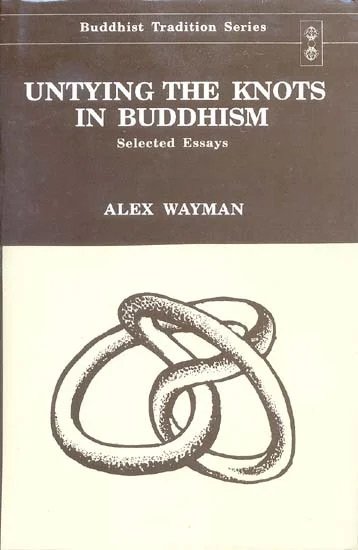Untying the Knots in Buddhism
author: Alex Wayman
edition: 1997, Motilal Banarsidass Publishers Pvt. Ltd.
pages: 631
ISBN-10: 8120813219
ISBN-13: 9788120813212
Topic: Buddhism
Introduction
The present volume of twenty four essays is intended as a companion to the previous volume of twenty four essays published under the title Buddhist Insight that was edited by George Elder and published by Motilal Banarsidass, Delhi (in 1984). The present volume is necessarily edited by myself since various articles had to be modified from their original forms and also since there has been a number of article substitutions in the volume as it was originally conceived some years ago. It would have been easier for the author to have used previously published articles to fill up the volume but the author engaged in a considerable amount of further writing so as to achieve an integrated volume rather than a collection of miscellaneous essays.
In the final form of this text the first two groups of essays emphasize the Buddha and his Samgha among the three Jewels of Buddhism the next two groups go with the Dharma Jewel. The fifth group of essays (Hindu Buddhist Studies) is pursuant tot eh author’s position that Buddhism cannot be divorced from its origin amidst the currents of Indian culture.
The superimposition of the number twenty four is certified by words of the Sanskrit Language siddha (perfect) is a name of the number 24 and the term parama in the meaning highest point is in the compound catur vimasti parama at the utmost 24.
The title’s expression untying the knots has two applicable interpretations (1) Solving Problems. The author claims to untie knots by trying to solve problems of Buddhism whether of biography history or doctrine. This is a procedure that tacitly opposes the frequent copying of previous theories without evaluation although admittedly many previous theories about Buddhism are correct indeed (2) Loosening the previous fixation. Here untying the knots is equivalent to the scripture title Samdhinirmocana the basic scripture of the Yogacara school. The title implies the charting of a new course. While the present volume reflects such a procedure to some extent namely a new approach the author admits his own effect cannot compare with that of the named scripture.
The attentive readers will probably notice repetition of some citations in these essays. While the writer tried to suppress such repetitions some probably remain due to the length of years that separate various essays as the writer returned to certain problems in a different context. On the positive side it may be an evidence of essay compatibility.
The transcription of Tibetan words should be mentioned. In my early essays. I used the system employed by the Russian Buddhologist Obemiller. Later I have adhered interpretations (1) Solving problems the author claims to untie knows by trying to solve problems of Buddhism, whether of biography history or doctrine. This is a procedure that tacity opposes the frequent copying of previous theories without evaluation although admittedly many previous theories about Buddhism are correct indeed. (2) Loosening the previous fixation. Here untying the knots is equivalent to the scripture title Sambhinirmocana the basic scripture of the Yogacara scholl. The title implies the charting of a new course. While the present volume reflects such a procedure to some extent namely a new approach the author admits his own effect cannot compare with that of the named scripture.
The attentive readers will probably notice repetition of some citations in these essays. While the writer tried to suppress such repetitions some probably remain due to the length of years that separate various essays as the writer returned to certain problems in a different context. On the positive side it may be an evidence of essay compatibility.
The transcription of Tibetan words should be mentioned. In my early essays I used the system employed by the Russian Buddhologist Obemiller. Later I have adhered to the library of Congress official transcription system for Tibetan language. More recently I have used the Wilie system which dispenses with most diacritics. The author must apologize to the reader for such inconsistencies in the present set of essays but readers of the Tibetan language will find little difficulty in recognizing the words by such transcriptions.
